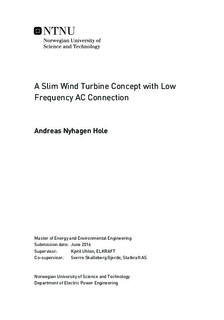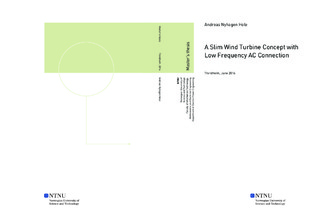| dc.description.abstract | This thesis aims to investigate the feasibility of using a slim wind turbine concept together with a low frequency alternating current (LFAC) transmission system in an offshore wind farm system. By a slim wind turbine concept, it is referred to a wind turbine where the converter is excluded. The idea is to use large direct drive PMSGs that will output a low frequency AC directly. The proposed system will have all wind turbines operating synchronously where an onshore converter station will be able to control the whole wind farm. The work has focused on developing a model in MATLAB Simulink, implementing a suitable control system and study different ways of minimizing losses. The challenges that the proposed system faces are highlighted and measures to minimize the reactive flow in the system has been tested.
The wind turbine is based on the 10 MW NOWITECH reference turbine. Aggregated models are utilized in order to save computational time. An average model is used to model the onshore converter where only the generator side converter is included. The development of the model is explained in the thesis and further improvements are suggested.
The control system implemented in the frequency converter is based on the power signal feedback control. The difference between those will be that the converter controls the frequency, and hence the speed, based on power measurements. Obtaining an optimal frequency versus power curve as a reference for the control system is proved to be difficult as the losses in the system varies with the system frequency. The results show the clear disadvantage of having all turbines operate synchronously when they are exposed to different wind speeds as this results in lost power production compared to a system with independently speed control.
Varying the system frequency will have an impact on the components in the system. Lowering the frequency results in less reactive power generated in the cable while the the shunt reactors will demand more reactive power. The results also showed that the generators starts to draw a serious amount of reactive power in order to maintain the active power production at rated voltage level. This proves the necessity of FACTS-devices and hence an active compensation was tested. Due to the simplifications made this resulted in severe oscillations in the system. The oscillations were proven to have a frequency equal to the system frequency which could prove this system to be infeasible. Further research and testing of this feature should be carried out.
Operation at a lower transmission voltage level was also tested during a wind farm power production of 0.6 pu. By lowering the voltage, the charging currents will be reduced and hence the losses will be reduced. The results showed that by lowering the voltage level to 0.8 pu the losses were reduced by 9.29 $\%$ when no other changes in the model were done. Lowering the losses is an important economic factor, but it will also increase the feasible operation range, allowing the system to operate under even lower wind speeds. | |

